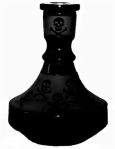A recent court decision relating to the design of a hookah’s water container highlights the distinction between “works of authorship” (which can be protected under copyright law) and “useful articles” (which cannot).
In Inhale Inc. v. Starbuzz Tobacco, Inc. (C.D. Cal. June 8, 2012), Inhale registered a copyight for its water container for use with a hookah. The 
registration was for a “sculpture/3-D artwork” and included a photograph showing the shape of the container with a skull-and-crossbones graphic imprinted on the container.
When Starbuzz began selling a similar-looking water container, Inhale sued Starbuzz for copyright infringement. In the lawsuit, Inhale disclaimed any copyright protection to the skull-and-crossbones graphic and instead focused on the shape of the container. In its defense, Starbuzz countered that the shape was not copyrightable, because of its functional purpose.
The Copyright Act protects sculptures and other “works of authorship fixed in any tangible medium of expression.” (17 U.S.C. 102). However, copyright protection is not available for works “having an intrinsic utilitarian function that is not merely to portray the appearance of the article or convey information.” (17 U.S.C. 101.) The court noted that “the overall shape of a useful article is not copyrightable ‘no matter how aesthetically pleasing that shape may be.'”
In the case, the court said that the water container’s shape could not be separated from its utilitarian function: “The artistic aspects – if any – of [Inhale’s] water container shape, are not separable from its utilitarian elements.” The court considered Inhale’s purpose in creating the design to be relevant, noting that “the fact that Plaintiff intended its water container to serve as a liquid holding receptacle for a hookah — and not as a museum piece — is what matters.”
The court’s statements raise a difficult bar for makers of useful articles that have creative and unique designs, as they suggest that the shape of a useful article can never be protected — no matter how artistic. It is unlikely that the court intended such a broad conclusion, and the ultimate result will likely depend on the amount of “art” that is embodied in the design.
Although not expressly stated in the court’s opinion, the fact that Inhale did not apply to register its copyright until it was about to file suit in 2011 — after selling the product for approximately three years — may have been a factor in the court’s decision. Waiting to register the copyright until infringement occurred seemed to work against the plaintiff, as the court may have interpreted the delay as evidence of the plaintiff’s intent when creating the design. Because of this, creators of artistic-but-useful articles should consider applying for copyright registration as early as possible.

